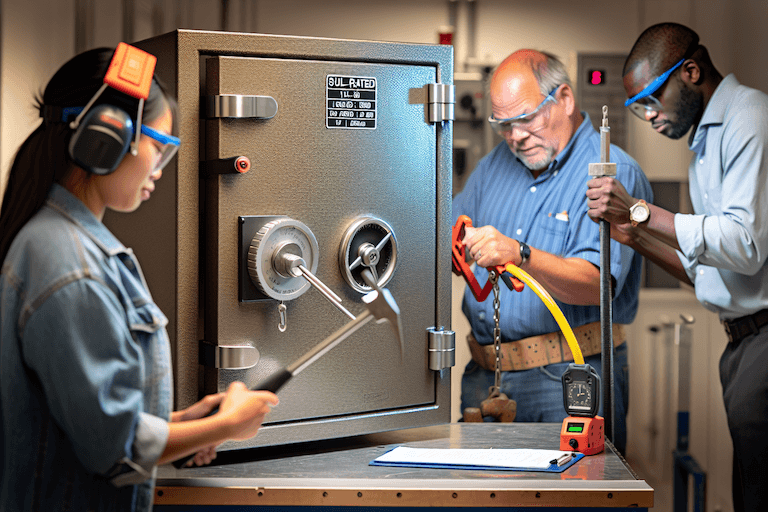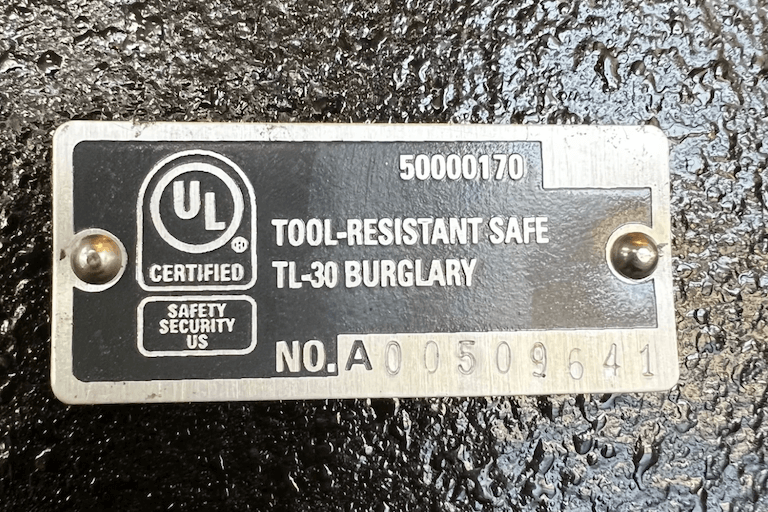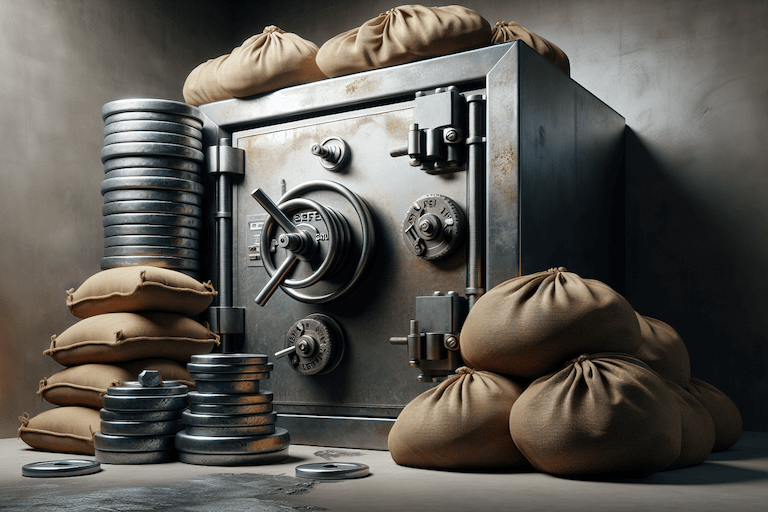
Safe Burglary Ratings Explained: A Comprehensive Guide
Securing your valuables against potential burglary is a priority for both individuals and businesses. A key component of this safety measure is the investment in a high-quality safe. However, understanding the different safe burglary ratings can be a daunting task.
This guide aims to demystify safe burglary ratings, helping you make an informed decision when purchasing your next safe.
Understanding Safe Burglary Ratings
Safe burglary ratings are standards developed by the insurance industry and independent testing organizations like Underwriters Laboratories (UL).
These ratings provide a benchmark of the level of protection a safe provides against burglary attempts. The ratings consider both the construction and performance of the safe under test conditions.
Insurance Ratings vs. Performance Testing Ratings
In regards to burglary ratings for safes, they come in two main forms: insurance ratings and performance testing ratings.
Insurance ratings, such as ‘B,’ ‘C,’ ‘E,’ ‘ER’ (E Revised), ‘F,’ and ‘G&A,’ reflect the construction quality of a safe and in turn an average value of contents they can be expected to protect.
On the other hand, performance testing ratings, evaluated by renowned third-party organizations like Underwriters Laboratories (UL), measure a safe’s actual capability to resist break-ins and attacks based on passed standardized tests defined by these organizations.
These ratings simulate real-world break-in scenarios, offering a glimpse into the safe’s performance under pressure. While insurance ratings focus on construction aspects, performance testing ratings derive from active testing methods.
Comprehending both ratings is vital for accurately evaluating a safe’s protection level for insurance and security purposes.
Common Burglary Ratings: B-Rate, C-Rate, E-Rate, and RSC
Looking at details, we begin with the most common burglary ratings: B-Rate, C-Rate, and E-Rate. No tests have been carried out for safes to achieve these ratings.
B-Rate safes are constructed with a minimum of 1/4-inch body and a 1/2-inch door, making them suitable for everyday security needs. C-Rate safes are built with a more robust 1/2-inch thick steel body and a 1-inch thick door, offering a higher degree of security.
For those in search of an even more secure option, E-Rate safes are designed with 1-inch thick walls and a door that's 1.5 inches thick, akin to TL-15 safes but lacking independent testing certification (see below).
UL Residential Security Containers (RSC)
Stepping aside from the alphabet ratings, we turn our focus to Residential Security Containers (RSC), a classification offered by Underwriter Laboratories (UL) for a range of products that do not meet their minimum UL Certified ratings (see below).
An RSC-rated safe is required to endure five to ten minutes of rigorous attacks by UL technicians with specific tools, including:
-
prying
-
drilling
-
punching
-
chiseling
-
tampering
The RSC rating offers three levels of security:
-
RSC Level 1: Requires the safe to resist five minutes of break-in attempts by 1 person using common hand tools.
-
RSC Level 2: The safe can provide resistance for at least 10 minutes against an attack by 2 people.
-
RSC Level 3: A conceptual level that denotes the highest degree of protection.
Let’s probe further into these levels to comprehend what each one implies.
RSC Level 1
RSC Level 1 safes are designed to resist five minutes of rigorous break-in attempts by a single individual using common hand tools.
These safes require a UL Group II combination lock or Type 1 electronic lock, a door equivalent to 3/16-inch thick steel, and walls made of at least 12-gauge steel.
While the certification requirements might seem stringent, they guarantee the safe’s ability to resist an array of break-in methods, including prying, punching, drilling, and tampering among others for at least 5 minutes.
Quality features indicating a robust RSC Level 1 safe include a higher number of locking bolts, greater bolt diameter, presence of re-lockers, concrete lined walls, and hardened steel plates.
RSC Level 2
Scaling up, RSC Level 2 safes are rated to withstand an attack by two individuals using advanced tools for a duration of 10 minutes.
This level offers increased security by requiring the safe to resist more aggressive and collaborative break-in efforts for double the time.
Although not as common as RSC Level 1, RSC Level 2 represents an enhanced protection standard, suggesting superior security features for safeguarding valuables.
RSC Level 3
Raising the bar even higher, RSC Level 3 is a conceptual burglary rating, proposed to provide higher security than available RSC levels. These safes are theorized to withstand an attack by three technicians using an advanced array of tools for a period of 10 minutes, showcasing the constant evolution of safety standards.
The RSC Level 3 aims to improve security by decreasing the permissible opening size during testing to no larger than two-square-inches, contrasting with the six-square-inch allowance of RSC Level 2. Although not yet present in the marketplace, the conceptual RSC Level 3 rating signifies the industry’s ongoing quest for providing consumers with the most secure storage solutions.
UL-Rated Safes: TL-15, TL-30, TL-30x6 and TLTR-30x6
Turning our attention to UL-rated safes, these high-security vaults stand up against the rigorous standards established by Underwriters Laboratories (UL).
The UL certification on safes is recognized as a dependable high-quality assurance, indicating that a safe has undergone rigorous testing procedures.
The TL-15, TL-30, TL-30x6 and TLTR-30x6 ratings represent the pinnacle of burglary resistance, making them ideal as business safes.
These safes are designed to withstand extensive break-in attempts using a range of tools, offering a highly regarded level of burglary protection and insurance ratings from "E" to "G&A", making them suitable for commercial use and protecting high value contents.
TL-15 Safes
TL stands for "Tool Resistant" and the number 15 refers to the time of resistance, in minutes.
TL-15 safes require a construction of at least one inch solid steel on all sides and at least a 1.5 inch thick steel door, providing substantial resistance against break-ins.
These safes undergo thorough independent testing and must demonstrate their ability to withstand at least 15 minutes of continuous attack on the door or face of the safe using various tools. Learn more about the Tl-15 rating.
TL-30 Safes
TL-30 safes offer enhanced security by resisting break-in attempts on the door for at least 30 minutes. A TL-30 safe must meet the following requirements:
-
Body walls made of at least 1-inch thick open hearth steel.
-
A significant weight of at least 750 pounds or:
-
Anchoring available to concrete floors if lighter than 750 pounds.
- U.L. Listed Group 2M, 1, 1R Combination Lock or Type 1 Electronic Lock
-
Resistance against attacks from professional safe crackers using tools like high-speed drills, sledgehammers, and power saws for up to 30 minutes.
Learn more about the TL-30 rating here.
TL-30x6 Safes
For those seeking comprehensive six-sided protection, TL-30x6 safes are an even better choice. These safes are rigorously tested by Underwriters Laboratory (UL) on all six sides using powerful tools for a duration of 30 minutes.
Compared to the TL-30 safe rating, TL-30x6 safes are considered twice as strong due to their ability to resist break-in attempts on all six sides. Learn more about the TL-30x6 rating here.
The requirements include:
-
Body walls at least 1" open hearth steel with a minimum tensile strength of 50,000 P.S.I.
- Must weigh at least 750 lbs or come with instructions for anchoring.
- U.L. Listed Group 2M, 1, 1R Combination Lock or Type 1 Electronic Lock.
-
Additional security enhancements such as a three-way boltwork, an auxiliary key lock, and glass relocking systems.
TLTR-30x6 Safes
For the ultimate in security, TLTR-30x6 safes stand as the giants in the realm of safes, combining the formidable features of TL-30x6 safes with advanced torch and tool resistance.
These safes are subjected to the most rigorous tests conducted by Underwriters Laboratories, designed to withstand not just tools, but also torches for a minimum of 30 minutes.
The "TR" in TLTR-30x6 denotes "Torch Resistance," indicating that these safes can resist attacks involving cutting torches that can generate extremely high temperatures, capable of slicing through most metals.
The TLTR-30x6 rating is an assurance that the safe provides a comprehensive shield against a variety of break-in methods.
Here are some of the standout features of TLTR-30x6 safes:
-
A robust body with a minimum thickness of 1 inch, featuring a blend of concrete-based fireproof materials and steel for maximum durability.
-
A door that integrates multiple layers of fire-resistant materials and sophisticated locking mechanisms to resist both mechanical and thermal attacks.
-
A locking system that includes high-security locks, multiple relockers, and intricate bolt work to thwart any unauthorized entry attempts.
-
A construction that meets or exceeds the stringent standards set by insurance companies and security professionals for the storage of high-value items.
TLTR-30x6 safes are the epitome of secure storage, offering peace of mind to those who need to protect their most valuable and irreplaceable assets from the most determined and equipped of thieves.
Tips for Selecting the Right Safe for Your Security Needs
When it comes to choosing a safe, the security of your valuables is paramount. The process of selecting the perfect safe involves more than just picking a size and price; it requires a thorough understanding of burglary ratings and the types of attacks your safe may need to withstand. Here are the steps to guide you through the selection process:
-
Take inventory of the items you wish to secure, including their size and value.
-
Anticipate the potential growth of your valuables collection to ensure the safe can accommodate future needs.
-
Confirm that the intended location for the safe can handle its dimensions and weight.
-
Consider the types of burglary attacks prevalent in your area and choose a safe with appropriate resistance features.
Assessing Your Valuables and Risk Factors
Begin by evaluating the items you need to protect. This involves considering the monetary value, sentimental worth, and how easily they could be replaced if lost or stolen.
Understanding the potential threats—be it burglary methods or the level of crime in your area—will influence the type of safe you should consider. The right safe should have the appropriate burglary rating and be equipped with a lock mechanism that offers both security and convenience for your situation.
Balancing Cost, Quality, and Features
The cost of a safe should be commensurate with the value of the items it's meant to protect. A more expensive safe typically offers higher security features and better resistance to attacks.
Consider the maximum value of what you might store in the next several years to avoid the need for an upgrade. Remember that a safe is an investment in the protection of your valuables.
In Summary
Understanding safe burglary ratings is more than just deciphering a complex matrix of letters and numbers—it’s a crucial step in ensuring the utmost protection for your valuables.
By comprehending the nuances of insurance ratings, performance testing ratings, RSC levels, and UL ratings, you can select a safe that offers the highest level of security tailored to your specific needs.
From assessing your valuables and risk factors to balancing the cost, quality, and features of different safes, each step in the selection process plays a pivotal role in safeguarding your precious belongings.
Remember, investing in a safe is not just about buying a storage unit—it’s about securing peace of mind.



